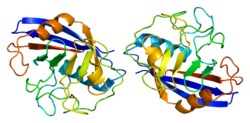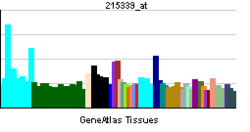- NKTR
-
Natural killer-tumor recognition sequence 
PDB rendering based on 2he9.Available structures PDB 2he9 Identifiers Symbols NKTR; DKFZp686F1754; DKFZp686G0426; DKFZp686J06106; DKFZp686N24126; MGC90527; p104 External IDs OMIM: 161565 MGI: 97346 HomoloGene: 122148 GeneCards: NKTR Gene EC number 5.2.1.8 Gene Ontology Molecular function • peptidyl-prolyl cis-trans isomerase activity
• cyclosporin A binding
• isomerase activityCellular component • membrane Biological process • protein folding Sources: Amigo / QuickGO RNA expression pattern 
More reference expression data Orthologs Species Human Mouse Entrez 4820 18087 Ensembl ENSG00000114857 ENSMUSG00000032525 UniProt P30414 Q3TQ51 RefSeq (mRNA) NM_005385.3 NM_010918.2 RefSeq (protein) NP_005376.2 NP_035048.3 Location (UCSC) Chr 3:
42.64 – 42.69 MbChr 9:
121.63 – 121.67 MbPubMed search [1] [2] NK-tumor recognition protein is a protein that in humans is encoded by the NKTR gene.[1][2][3]
This gene encodes a membrane-anchored protein with a hydrophobic amino terminal domain and a cyclophilin-like PPIase domain. It is present on the surface of natural killer cells and facilitates their binding to targets. Its expression is regulated by IL2 activation of the cells.[3]
References
- ^ Young HA, Jenkins NA, Copeland NG, Simek S, Lerman MI, Zbar B, Glenn G, Ortaldo JR, Anderson SK (Jul 1993). "Localization of a novel natural killer triggering receptor locus to human chromosome 3p23-p21 and mouse chromosome 9". Genomics 16 (2): 548–549. doi:10.1006/geno.1993.1229. PMID 8314596.
- ^ Chambers CA, Gallinger S, Anderson SK, Giardina S, Ortaldo JR, Hozumi N, Roder J (May 1994). "Expression of the NK-TR gene is required for NK-like activity in human T cells". J Immunol 152 (6): 2669–74. PMID 8144875.
- ^ a b "Entrez Gene: NKTR natural killer-tumor recognition sequence". http://www.ncbi.nlm.nih.gov/sites/entrez?Db=gene&Cmd=ShowDetailView&TermToSearch=4820.
Further reading
- Frey JL, Bino T, Kantor RR et al. (1992). "Mechanism of target cell recognition by natural killer cells: characterization of a novel triggering molecule restricted to CD3- large granular lymphocytes". J. Exp. Med. 174 (6): 1527–1536. doi:10.1084/jem.174.6.1527. PMC 2119033. PMID 1720812. http://www.pubmedcentral.nih.gov/articlerender.fcgi?tool=pmcentrez&artid=2119033.
- Rinfret A, Anderson SK (1993). "IL-2 regulates the expression of the NK-TR gene via an alternate RNA splicing mechanism". Mol. Immunol. 30 (14): 1307–1313. doi:10.1016/0161-5890(93)90047-F. PMID 8413330.
- Anderson SK, Gallinger S, Roder J et al. (1993). "A cyclophilin-related protein involved in the function of natural killer cells". Proc. Natl. Acad. Sci. U.S.A. 90 (2): 542–546. doi:10.1073/pnas.90.2.542. PMC 45699. PMID 8421688. http://www.pubmedcentral.nih.gov/articlerender.fcgi?tool=pmcentrez&artid=45699.
- Strausberg RL, Feingold EA, Grouse LH et al. (2003). "Generation and initial analysis of more than 15,000 full-length human and mouse cDNA sequences". Proc. Natl. Acad. Sci. U.S.A. 99 (26): 16899–16903. doi:10.1073/pnas.242603899. PMC 139241. PMID 12477932. http://www.pubmedcentral.nih.gov/articlerender.fcgi?tool=pmcentrez&artid=139241.
- Ota T, Suzuki Y, Nishikawa T et al. (2004). "Complete sequencing and characterization of 21,243 full-length human cDNAs". Nat. Genet. 36 (1): 40–45. doi:10.1038/ng1285. PMID 14702039.
- Sakashita E, Tatsumi S, Werner D et al. (2004). "Human RNPS1 and its associated factors: a versatile alternative pre-mRNA splicing regulator in vivo". Mol. Cell. Biol. 24 (3): 1174–1187. doi:10.1128/MCB.24.3.1174-1187.2004. PMC 321435. PMID 14729963. http://www.pubmedcentral.nih.gov/articlerender.fcgi?tool=pmcentrez&artid=321435.
- Olsen JV, Blagoev B, Gnad F et al. (2006). "Global, in vivo, and site-specific phosphorylation dynamics in signaling networks". Cell 127 (3): 635–648. doi:10.1016/j.cell.2006.09.026. PMID 17081983.
PDB gallery Categories:- Human proteins
- Chromosome 3 gene stubs
Wikimedia Foundation. 2010.

